Infrastructure and operation teams across industries constantly look for efficient ways to build and deploy more agile, flexible, and scalable applications. The traditional method of manually configuring infrastructure environments is laborious and prone to errors.
To overcome this challenge, many organizations are now turning towards Infrastructure as Code (IaC). IaC provides DevOps and NetOps teams with a consistent way to automate the provisioning, configuration, and management of IT resources such as networks, storage systems, servers, VMs, and load balancers.
What is IaC?
Infrastructure as Code (IaC) is a method of managing and provisioning IT resources using code or machine-readable definition files instead of physical hardware configuration. IaC helps organizations reduce costs, increase speed and eliminate risks associated with manual configuration.
IaC is an important part of DevOps practices, as it helps to automate and standardize the provisioning of cloud resources. It also enables organizations to replicate environments quickly and accurately and scale their operations.
IaC Approaches
There are two approaches to IaC. They include declarative (functional) vs. imperative (procedural).
- Declarative (functional): The declarative approach uses the “desired state” concept to define the system requirements. In this approach, you only need to define the target configuration you want for your infrastructure, and the system will apply the necessary changes to reach that state.
- Imperative (procedural): The imperative approach uses a “step-by-step” or procedural method to define the environmental requirements. This approach requires you to provide instructions that must be followed to reach the desired configuration.
Geekflare has researched and listed the best IaC tools you can use today to automate your infrastructure configuration deployment. Most of the listed below offer open-source version, which is good to try in your non-production environment.
Terraform
Terraform by HarshiCorp is an open-source IaC tool. It provides a consistent workflow to provision and manage your infrastructure on any cloud, including public, private, and hybrid cloud environments.

With Terraform, users can define their cloud infrastructure in a declarative configuration language called HashiCorp Configuration Language (HCL). The Terraform platform then automates the creation and management of cloud infrastructure based on the defined configuration.
Terraform Features
- Terraform supports operating systems, including Linux, FreeBSD, macOS, OpenBSD, Solaris, and Microsoft Windows.
- Terraform works well with existing DevOps workflows and popular orchestration frameworks like Kubernetes.
- Integrates with version control system (VCS), Information technology service management (ITSM), and Continuous integration (CI) and continuous delivery (CD) pipelines
- It can be used for multi-cloud deployment.
- Manage network infrastructure, such as updating load balancer member pools or applying firewall policies.
The solution is available in two versions –a free, downloadable open-source self-managed that can run locally with your environment and a paid version, Terraform Cloud for team and governance, starting at $20 per user – They also offer a business plan which features drift detection, SSO, audit logs, self-hosted agents and custom concurrency. Pricing for the business plan is available upon request.
Pulumi
Pulumi advertises its platform as “infrastructure as code for engineers.” It can provision infrastructure with a mix of languages and technologies, including TypeScript, Python, Go, C#, and JavaYAML.

The open-source platform is designed to help developers create and manage cloud resources across different providers. Pulumi also offers project templates for various use cases, including Containers, Kubernetes App, Kubernetes Cluster, Serverless, Static Websites, and VMs.
Pulumi Features
- Role-based access control (RBAC)
- Integrates with several CI/CD systems, including AWS code service, Circle CI, GitLab CI, Jenkins, Azure DevOps, and more.
- Provides audit logs for tracking user activities within the organization
- Support multiple languages, such as Python, TypeScript, JavaScript, Go, C#, F#, Java, and YAML
- Pulumi provides policy as code through CrossGuard – an open-source tool that lets you write rules in Python, JavaScript, or Open Policy Agent (OPA) Rego
Pulumi offers multiple paid plans, including a team plan, an enterprise plan (custom pricing), a business-critical plan (custom quote), and a free plan for an individual. They also offer a 14-day free trial.
Env0
Env0 is an IaC automation platform designed to help DevOps teams manage multi-cloud and cloud-native environments. Teams use it to exercise precise control over cloud resources, enhancing operational efficiency and helping engineers to implement solid governance policies.
Once you’ve integrated Env0 with your preferred cloud providers, IaC frameworks, observability tools and version control systems, the custom workflow feature allows you to run your own commands and perform supplemental actions. A good example is injecting custom variables into your infrastructure-as-code platform before applying them to the outputs of your deployment.
Env0 is built to ease deployment. This tool reduces pipeline maintenance and manual tooling, allowing developers to focus on the big problems. Env0 also makes it easy to troubleshoot problems by providing detailed progress reports on deployment, reducing the likelihood of solvable issues reaching production.
Estimating the cost impact of each IaC change is easy when using Env0. The automatic tagging functionality allows you to monitor actual costs incurred during each deployment. This feature makes it easy to manage usage-priced cloud resources.
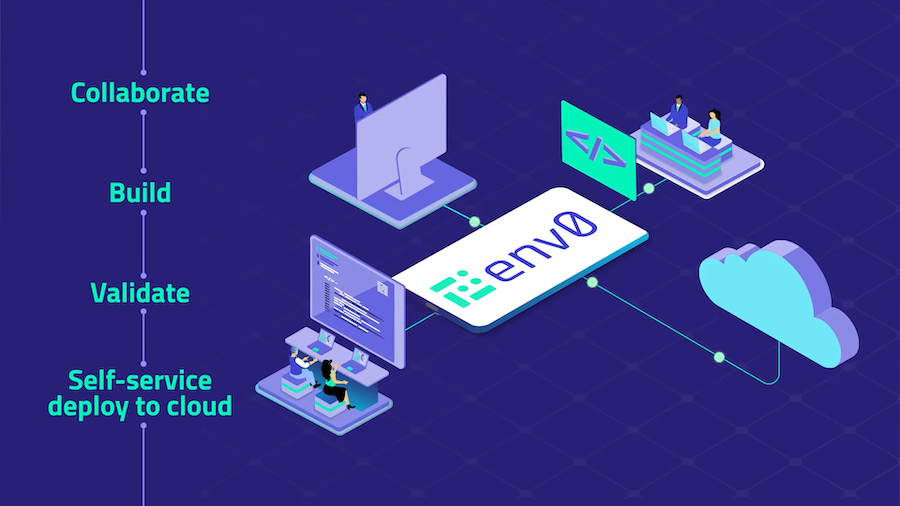
Env0 Features
- Integrates with leading IaC frameworks like Terraform, Helm, Kubernetes, Pulumi, etc.
- Env0 eases collaboration between different teams and members through shared templates.
- Env0 automates basic processes so that developers can focus on functionality.
- Makes it easy to address and solve emerging issues before they reach production.
Env0 has a free plan that allows unlimited concurrent runs. However, you can only have a maximum of 3 users and 50 monthly deployments. The Pro plan costs $349/mo and offers improved features, such as up to 50 users and 200 monthly deployments. Env0 also offers a Custom plan for enterprises.
Spacelift
Spacelift is a CI/CD solution built for cloud-agnostic IaC software. Spacelift development platform is built around the concept of policy-as-code using an open policy agent (OPA) framework, which allows users to define policies that involve various decision points in the application, such as login, access, approval, and initialization decision.
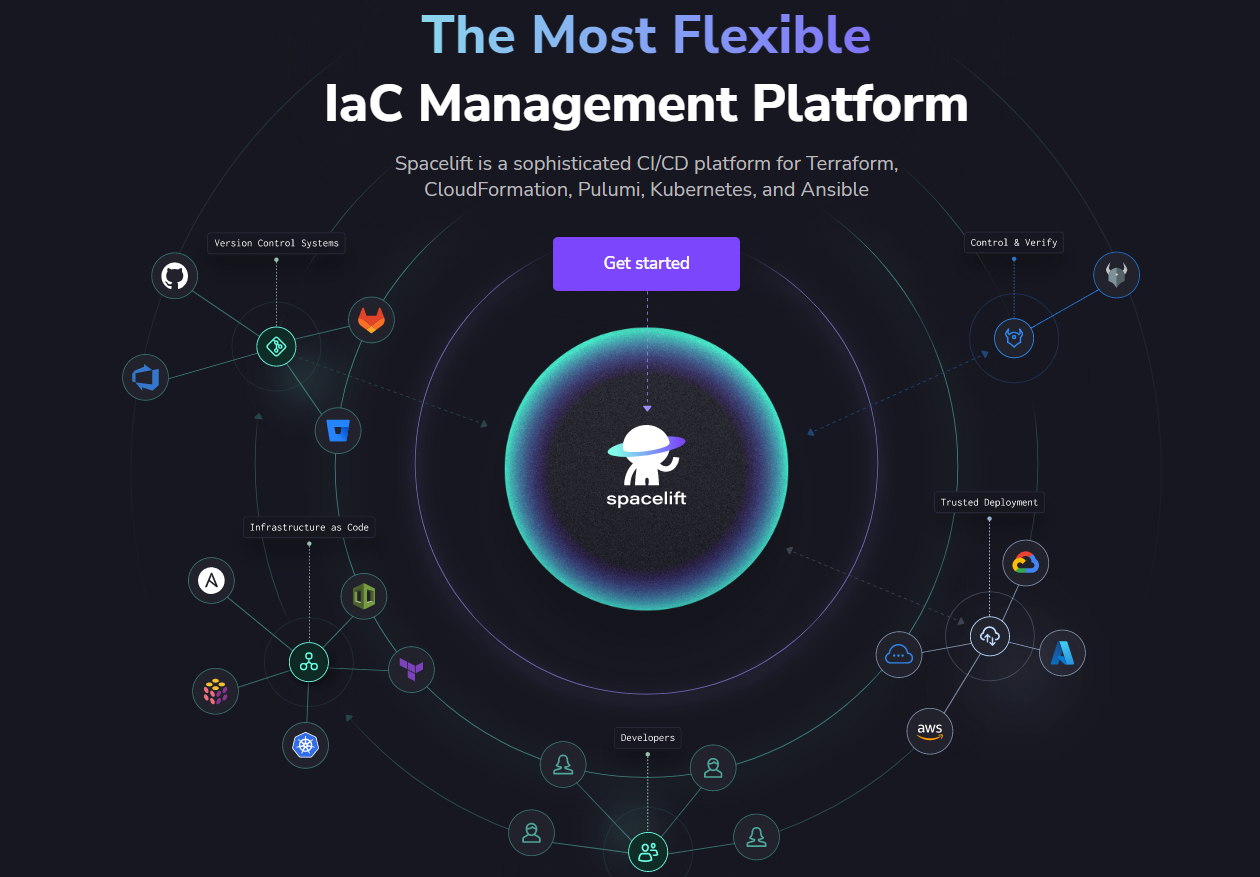
Spacelift Features
- Offers declarative workflow management with an open policy agent (OPA)
- Supports SAML 2.0 compliant identity provide
- Integrates with Terraform, CloudFormation, Pulumi, and Kubernetes
- Support role-based security policies, custom approval flows, and arbitrary git flow.
- Supports several cloud platforms (AWS, GCP, and Microsoft Azure)
Spacelift offers a 14-day free trial and various paid plans, depending on the customer’s requirements.
AWS CloudFormation
AWS CloudFormation is a service that enables you to model, provision, and manage AWS and third-party resource deployments predictably and repeatedly. It allows you to build applications on other Amazon products like Amazon EC2, elastic block store, SNS, elastic load balancing, and auto-scaling without having to configure the underlying AWS infrastructure.
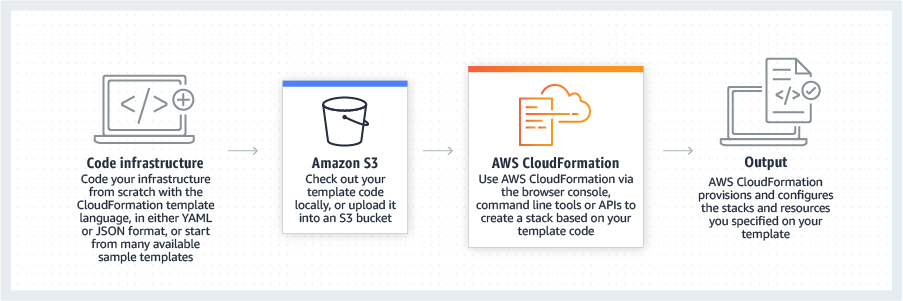
AWS CloudFormation Features
- It allows you to use open-source declarative languages like JSON or YAML.
- Define your cloud environment using TypeScript, Python, Java, and .NET.
- Model and provision third-party resources and modules published by AWS Partner Network (APN) and the developer community.
- Build serverless applications with SAM.
AWS CloudFormation uses pay per-user pricing model, and they only charge your per handler operation create, update, delete, read, or list actions. They offer a free tier with limited options. You may contact the AWS CloudFormation sales team for custom quotes or use the AWS pricing calculator to get an estimate.
Puppet
Puppet is an open-source configuration management and automation platform designed to provision resources, manage infrastructure, and achieve and maintain compliance in your on-prem systems, cloud infrastructure, or in your hybrid IT environment.
Puppet Features
- Puppet supports AWS, Microsoft Azure, GCP, VMware, Windows, Linux, Windows OS, and Oracle.
- It offers extensive integrations with various cloud services, DSC resources, infrastructure, policy-as-code, secret management, and virtualization technologies.
- Real-time monitoring and reporting capabilities enable you to find drift and compliance errors.
- Uses policy-as-code to streamline and enforce compliance.
Puppet rates aren’t published on their website, but you can fill out a short form on the website pricing page to request quotes.
Progress Chef
Chef provides a flexible framework for infrastructures, applications, and services deployment and management. The Chef platform comprises components such as cookbooks, recipes, roles, and environments which are used to create and manage the desired infrastructure state.
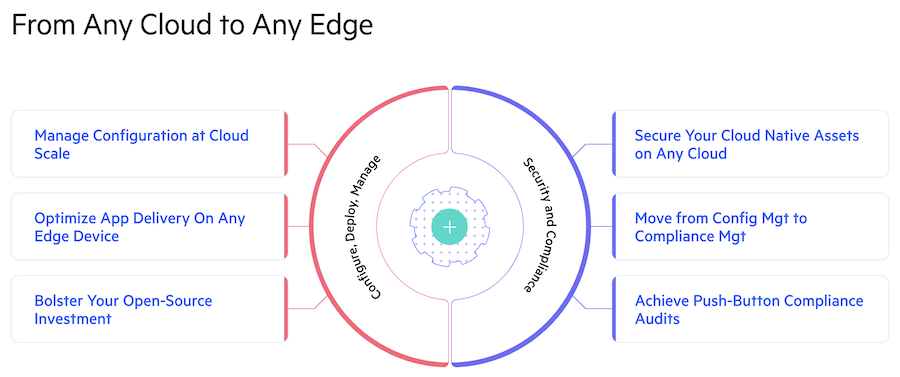
Chef Features
- Integrates with Azure, AWS, Docker, Kubernetes, Terraform, and VMware
- AIOps support
- Automates security, infrastructure, and application
- Support Multi-OS, multi-cloud, on-premises, hybrid, and complex legacy architectures.
- Continuous delivery pipeline automation
- Automated remediation in case of configuration drift
You can purchase this software as an on-premise or SaaS solution by contacting the Chef sales team for custom quotes or buying it from Azure or AWS marketplace.
Crossplane
Built on Kubernetes, Crossplane is an open-source platform that orchestrates applications and infrastructure. It allows you to build a control plane with Kubernetes-style declarative and API-driven configuration to manage your application stacks, allowing efficient DevOps processes.
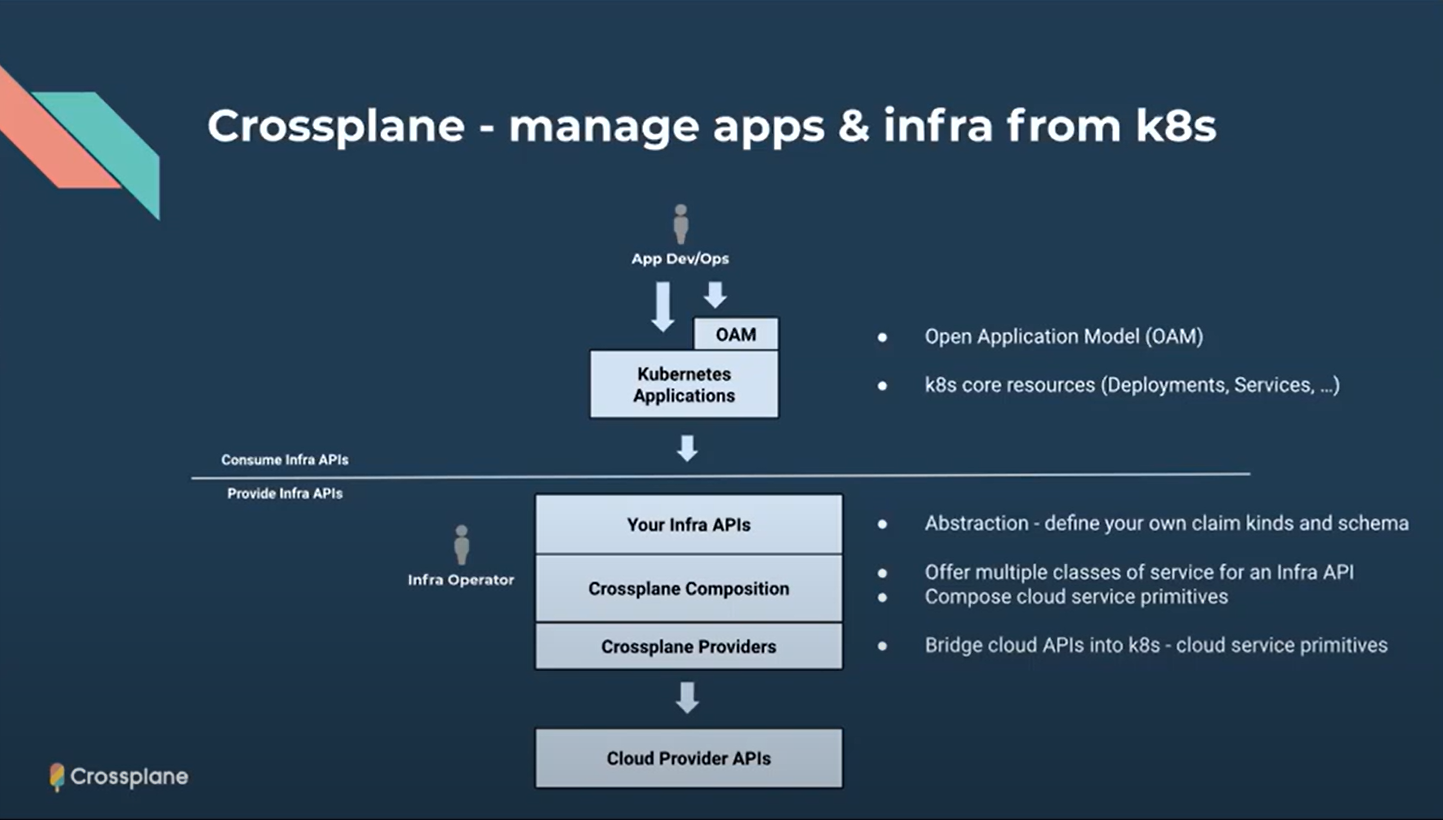
Crossplane Features
- Role Based Access Control (RBAC)
- Declarative configuration
- Integrates with CI/CD pipelines
- Automate operational tasks by reconciling controllers
The tool allows users to self-service control planes and offer a single control point for policy and permissions.
Brainboard
Brainboard is a collaborative tool built for engineers, cloud architects, DevOps, and infrastructure managers to design & manage cloud infrastructures visually. The platform allows architects to drag and drop cloud infrastructure, data, custom resources, and Terraform modules from cloud providers supported by Terraform.
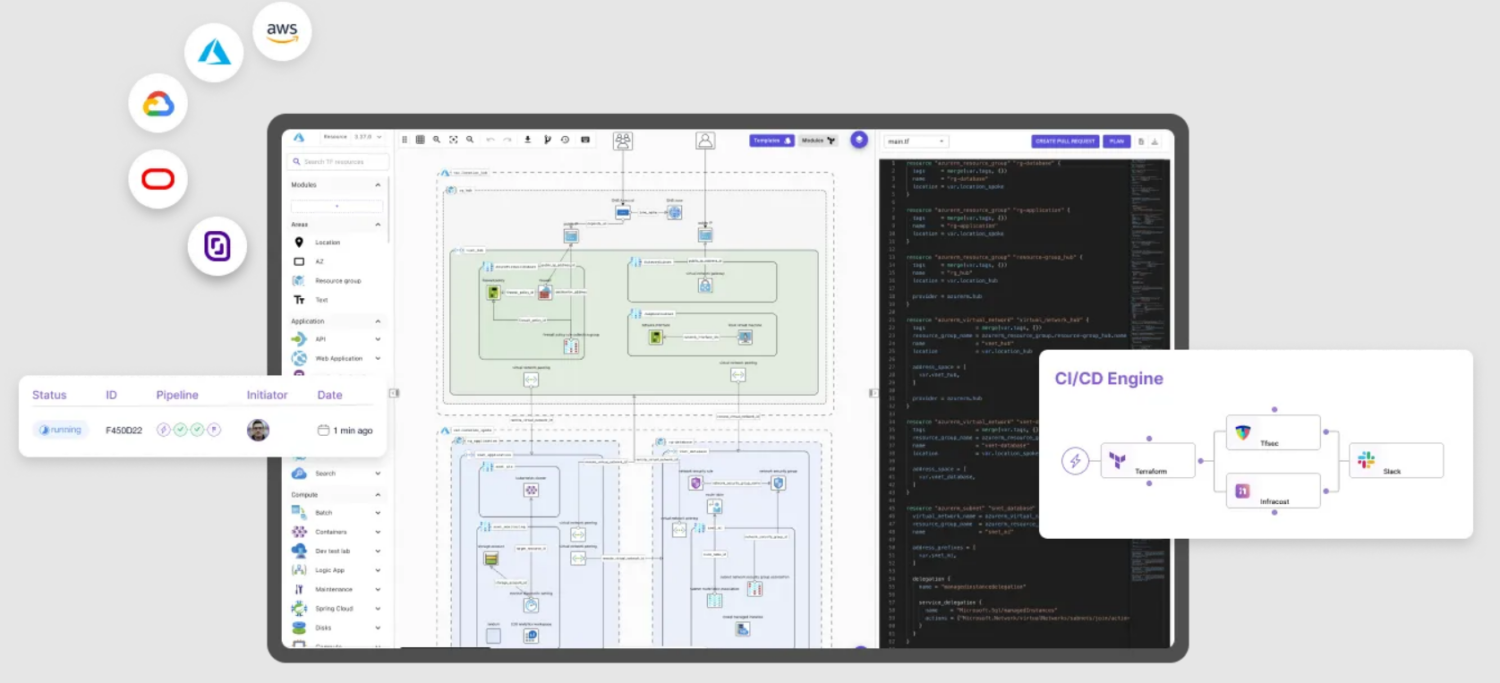
Brainboard Features
- Integrates with Azure, AWS, Oracle, and GCP
- Drag and drop capabilities
- Auto-generate terraform code
- Visually build CI/CD pipelines
- Self-service infrastructure
Brainboard offers two paid plans (pro and enterprise) and a free plan for a team of two users. The pro (for production and teams) plan starts at $99. Pricing for the enterprise plan is available on request.
Factors to Consider When Choosing IaC Tools
The best IaC solution for you depends on your infrastructure needs and preferences. There are various factors to consider when researching and shopping for IaC software.
Automation
Automation helps reduce the risks associated with human error due to manual deployment, configuration, and management of your infrastructure. Automated deployments can help keep costs low by reducing mistakes, improving speed, and optimizing workloads. Many IaC tools offer automation features, so it’s important to compare different products in terms of automation capabilities.
Scalability
DevOps best practices recommend having the ability to scale up or down easily and quickly to accommodate changing resource demands. Look for an IaC tool that offers scalability features such as dynamic orchestration or autoscaling. This will ensure that your environment is equipped with enough resources for current and future demands without overprovisioning or wasting resources. Some IaC tools even support advanced scalability options such as rolling updates or blue-green deployment strategies, allowing for safe, seamless updates without downtime or disruption.
Cost
One of the main advantages of using IaC tools is its cost savings compared to manual infrastructure setup and maintenance. The right IaC tool should balance cost efficiency with the features that matter most to your organization. Compare pricing models between vendors and check out free trials before deciding on a solution. Additionally, research what licensing fees may apply for additional users or third-party applications.
Integration and extensibility
When selecting an IaC tool, finding one that offers robust integration and extensibility options is important. Ensure the IaC tool has APIs for integrating with external services and systems and a library of plugins to extend the product’s capabilities. This allows you the flexibility to customize your workflow according to your specific needs. Additionally, good extensibility options allow you to create custom integrations and connectors if needed.
Security and support
Security should always be a priority when evaluating any technology. Many IaC solutions provide built-in security features like identity access management (IAM), encryption, and data loss prevention. It is also beneficial to select an IaC solution with dedicated customer service and technical support teams who can assist you throughout the implementation and adoption process. Find out what type of technical assistance they provide – whether it’s live chat, email, phone calls, or forums – so you know where to turn in case of problems.
Final thoughts
When shopping for the best IaC solution for your organization, you may be tempted to choose a solution associated with a popular company. Don’t just settle for the first option that seems to fit – find the one that is truly tailored to your needs.
The best tool for you depends on your specific needs and requirements. We recommend you do your own research, evaluate various tools, read product reviews on independent websites and ask for a product demo or sign up for a free trial (if available). This will enable you to assess the tools and select the best option for your business needs.

